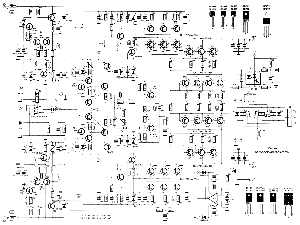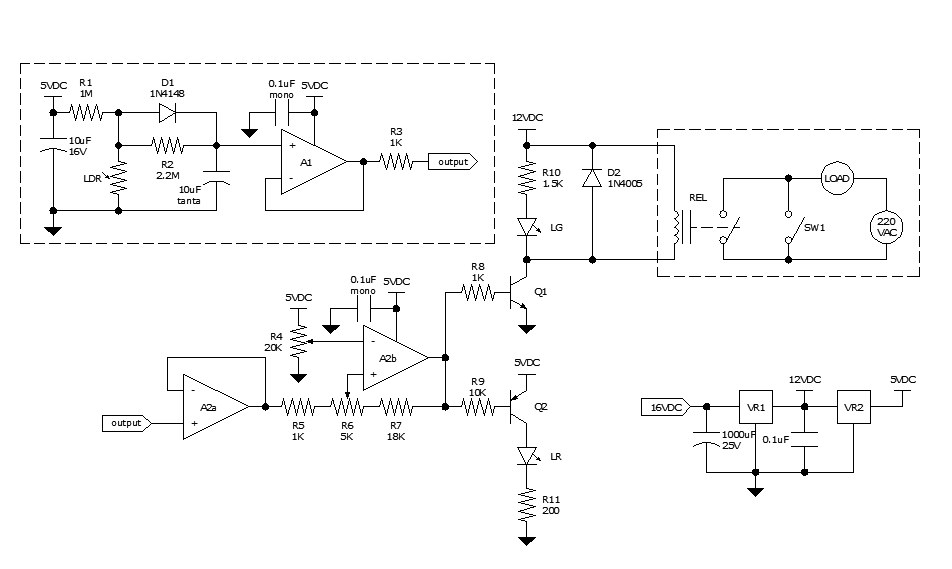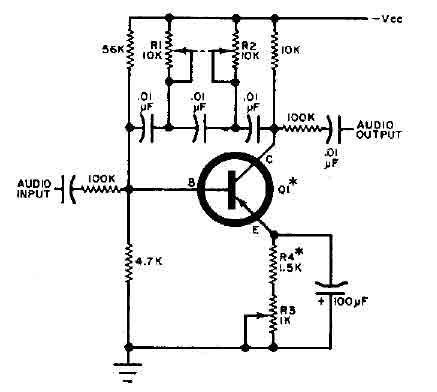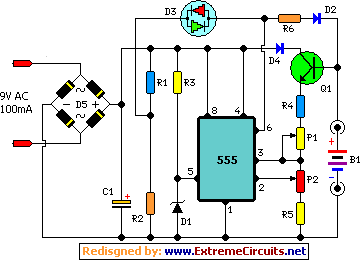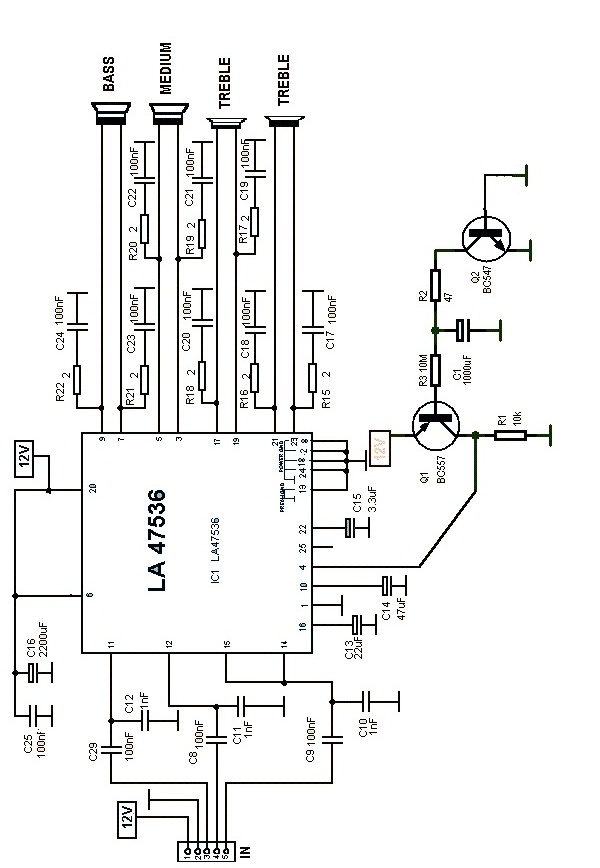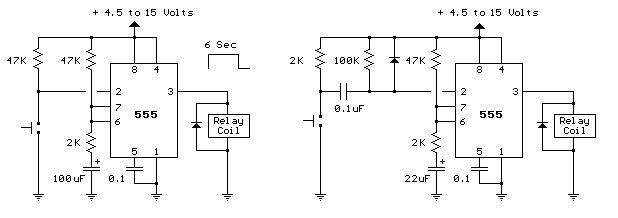
Single multi-lamp switch control circuit 2
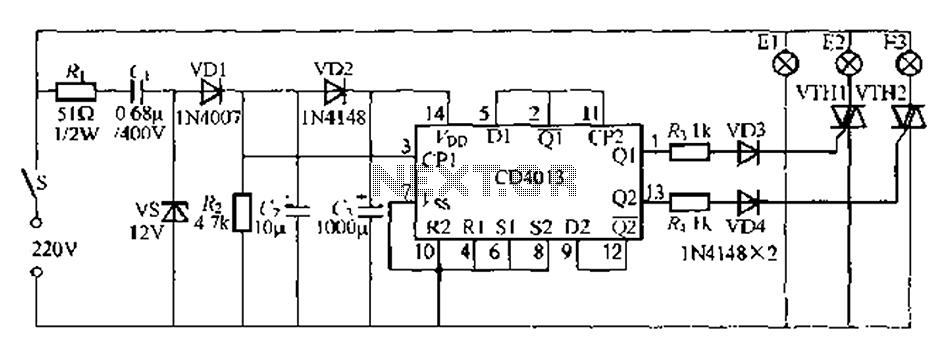
Figure 296 illustrates a control circuit that utilizes a switch (S) to manage three lamps (E1, E2, and E3) in a lighting system, suitable for controlling a chandelier in a living room. When the switch is off, all lights are turned off. When the switch is turned on, only lamp E1 illuminates. By briefly disconnecting the switch, lamps E1 and E2 can be lit together. If the switch is turned off again, lamps F1 and F3 will light up. Upon re-engaging the switch, all lamps E1, E2, and E3 will illuminate. The circuit includes a simple capacitive buck converter (G), a half-wave rectified voltage regulator (D1), and a storage capacitor (C1). The capacitor serves to store energy when the switch is off, ensuring reliable operation of the UPS (UM013). Diode VD2 functions as an isolation diode, allowing small forward current charging. The circuit also features a dual D flip-flop (D4), which acts as a counter device. The resistor (R1) determines the charge and discharge time constant, enabling the circuit to output a positive pulse count. The outputs Q1 and Q2 control the power levels. The timing variations in the outputs dictate which lamps are illuminated: with outputs at 00, only E1 is lit; with output 10, lamps E1 and E2 turn on; with output 01, lamps F1 and E3 illuminate; and with output 11, all lamps light up. The circuit employs a polypropylene capacitor (C13H-4) and J-type triacs (VTH1 and VTH2) for controlling the lamp operation. Other component specifications do not have special requirements.
The circuit described operates as a sophisticated lighting control system that can selectively illuminate multiple lamps based on the state of a control switch. This design is particularly advantageous for applications such as chandelier lighting, where different lighting scenarios may be desired. The inclusion of a capacitive buck converter allows for efficient energy management, ensuring that the system can operate effectively even during brief interruptions in power.
The half-wave rectifier (D1) provides a steady voltage to the circuit, while the storage capacitor (C1) ensures that the system can maintain functionality during transient states. The isolation diode (VD2) is crucial in preventing backflow of current, thus protecting sensitive components from potential damage.
The dual D flip-flop (D4) serves as a counting mechanism that tracks the number of switch activations. The timing and sequence of the output states (Q1 and Q2) are configured to control the triacs (VTH1 and VTH2), which in turn manage the power supplied to each lamp. The design allows for flexible control, enabling users to create various ambiance settings by simply toggling the control switch.
In summary, this circuit design not only provides basic lighting control but also incorporates advanced features that enhance user experience and reliability, making it suitable for modern residential applications.Fig. 296 can use a control switch S El, E2 and E3 three lamp light off. E is suitable for the living room chandelier control. When s off, lights all the fire; for the first tim e together on s, only E1 lit; disconnect S, short-term can be combined within LS, El and E2 lighted; A second break Ji fork turtle Xinhe LS, F1 and F3 point bright; again split off together f S. El-E3 light up. R., Composed of simple capacitive Buck G, v D1, vs the half-wave rectified voltage regulator, etc. c1 line. (For energy storage capacitor when s off fighting f, in time to make marital UM013 UPS can reliably count .VD2 trigger the isolation diode, so (j charge small forward grading electricity.
(, D4 013 is dual D flip-flop, which constitutes a counter device, since R, (1, charge and discharge time constant is small, S each station Ke I split off a second, R: that upper outputs a positive pulse count cI1 feet away! end count that Ql and Q2 ended output high power level by: OO bl0 01 11 00 -- timing variations when Ql, Q2 are output low, that is, 00., only lit E1, E2 and E3 small light; when the output 1 0 ef, thyristor VTH1 opened, so El, E2 lighted when the output 01, VTH2 opened, F1 and E3 lit; when the output ll when, VTHL and VTH2 are Ji Tong, lizard set of lights all light.
playing collapse CI3H-4 () OV polypropylene IU container .VTH1, VTH2 mouth J-type collapse MAC94A4 small plastic triac. other component parameters Figure, no special requirements.
The circuit described operates as a sophisticated lighting control system that can selectively illuminate multiple lamps based on the state of a control switch. This design is particularly advantageous for applications such as chandelier lighting, where different lighting scenarios may be desired. The inclusion of a capacitive buck converter allows for efficient energy management, ensuring that the system can operate effectively even during brief interruptions in power.
The half-wave rectifier (D1) provides a steady voltage to the circuit, while the storage capacitor (C1) ensures that the system can maintain functionality during transient states. The isolation diode (VD2) is crucial in preventing backflow of current, thus protecting sensitive components from potential damage.
The dual D flip-flop (D4) serves as a counting mechanism that tracks the number of switch activations. The timing and sequence of the output states (Q1 and Q2) are configured to control the triacs (VTH1 and VTH2), which in turn manage the power supplied to each lamp. The design allows for flexible control, enabling users to create various ambiance settings by simply toggling the control switch.
In summary, this circuit design not only provides basic lighting control but also incorporates advanced features that enhance user experience and reliability, making it suitable for modern residential applications.Fig. 296 can use a control switch S El, E2 and E3 three lamp light off. E is suitable for the living room chandelier control. When s off, lights all the fire; for the first tim e together on s, only E1 lit; disconnect S, short-term can be combined within LS, El and E2 lighted; A second break Ji fork turtle Xinhe LS, F1 and F3 point bright; again split off together f S. El-E3 light up. R., Composed of simple capacitive Buck G, v D1, vs the half-wave rectified voltage regulator, etc. c1 line. (For energy storage capacitor when s off fighting f, in time to make marital UM013 UPS can reliably count .VD2 trigger the isolation diode, so (j charge small forward grading electricity.
(, D4 013 is dual D flip-flop, which constitutes a counter device, since R, (1, charge and discharge time constant is small, S each station Ke I split off a second, R: that upper outputs a positive pulse count cI1 feet away! end count that Ql and Q2 ended output high power level by: OO bl0 01 11 00 -- timing variations when Ql, Q2 are output low, that is, 00., only lit E1, E2 and E3 small light; when the output 1 0 ef, thyristor VTH1 opened, so El, E2 lighted when the output 01, VTH2 opened, F1 and E3 lit; when the output ll when, VTHL and VTH2 are Ji Tong, lizard set of lights all light.
playing collapse CI3H-4 () OV polypropylene IU container .VTH1, VTH2 mouth J-type collapse MAC94A4 small plastic triac. other component parameters Figure, no special requirements.
